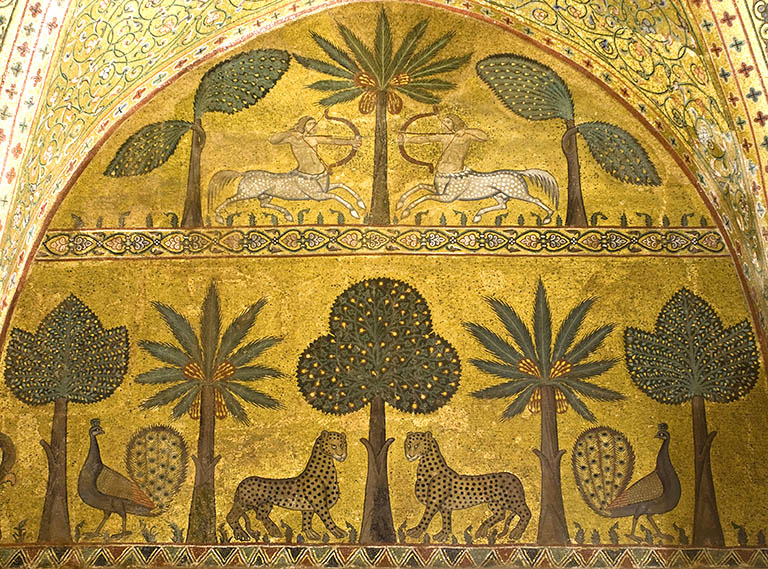 Above are mosaics that were laid by Byzantine artists from the court of Manuel I in Sicily. These are probably copies of mosaics he set up in his palace that Ibn Battuta describes below.
Above are mosaics that were laid by Byzantine artists from the court of Manuel I in Sicily. These are probably copies of mosaics he set up in his palace that Ibn Battuta describes below.
The Fabled Palaces of the Blachernae
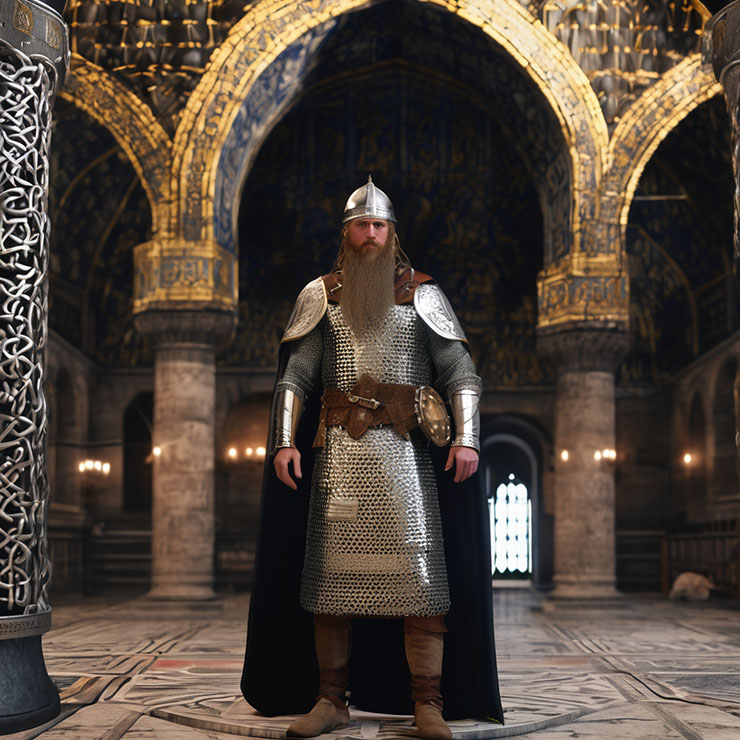 The Blachernae palaces were described as being upper or lower based on their position on the hill. The upper gate, Ta Hypsela, was closest to the Church of Mary Theotokos - south of it - and was the location of service buildings and the stables. Court officials did not live in the place, but came everyday for the regular ceremonies. There was a special quarter for them in the Blachernae called "ta Pittakia". Before the erection of the Comnenian palaces there were two buildings the hosted the Emperor when he came to Blachernae for church festivals and feasts. One was a big building called the Anastasiakos and the other was called the Danubius. These buildings may have been abandoned or fallen into ruin because they aren't mentioned after Alexios built his big "Alexiakos triklinos" which in Greek means Alexios hall but should be understood to describe a palace. These palaces were dominated by huge reception halls - at least two stories tall - that ran across the building lengthwise.
The Blachernae palaces were described as being upper or lower based on their position on the hill. The upper gate, Ta Hypsela, was closest to the Church of Mary Theotokos - south of it - and was the location of service buildings and the stables. Court officials did not live in the place, but came everyday for the regular ceremonies. There was a special quarter for them in the Blachernae called "ta Pittakia". Before the erection of the Comnenian palaces there were two buildings the hosted the Emperor when he came to Blachernae for church festivals and feasts. One was a big building called the Anastasiakos and the other was called the Danubius. These buildings may have been abandoned or fallen into ruin because they aren't mentioned after Alexios built his big "Alexiakos triklinos" which in Greek means Alexios hall but should be understood to describe a palace. These palaces were dominated by huge reception halls - at least two stories tall - that ran across the building lengthwise.
Benjamin of Tudela wrote of the Blachernae which he visited:
"This King Manuel built a great palace for the seat of his Government upon the sea-coast, in addition to the palaces which his fathers built, and he called its name Blachernae. He overlaid its columns and walls with gold and silver, and engraved thereon representations of the battles before his day and of his own combats. He also set up a throne of gold and of precious stones, and a golden crown was suspended by a gold chain over the throne, so arranged that he might sit thereunder. It was inlaid with jewels of priceless value, and at night time no lights were required, for every one could see by the light which the stones gave forth. Countless other buildings are to be met with in the city. From every part of the empire of Greece tribute is brought here every year, and they fill strongholds with garments of silk, purple, and gold. Like unto these storehouses and this wealth, there is nothing in the whole world to be found. It is said that the tribute of the city amounts every year to 20,000 gold pieces, derived both from the rents of shops and markets, and from the tribute of merchants who enter by sea or land."
"The Greek inhabitants are very rich in gold and precious stones, and they go clothed in garments of silk with gold embroidery, and they ride horses, and look like princes. Indeed, the land is very rich in all cloth stuffs, and in bread, meat, and wine. Wealth like that of Constantinople is not to be found in the whole world. Here also are men learned in all the books of the Greeks, and they eat and drink every man under his vine and his fig-tree."
Alexios's mother, Anna Dasselene, was first of the Comnenai to move to Blachernae. She had a special attachment to the Chapel of Saint Thekla. The new dynasty felt its fate, its success in gaining the throne, was somehow tied to the Blachernae.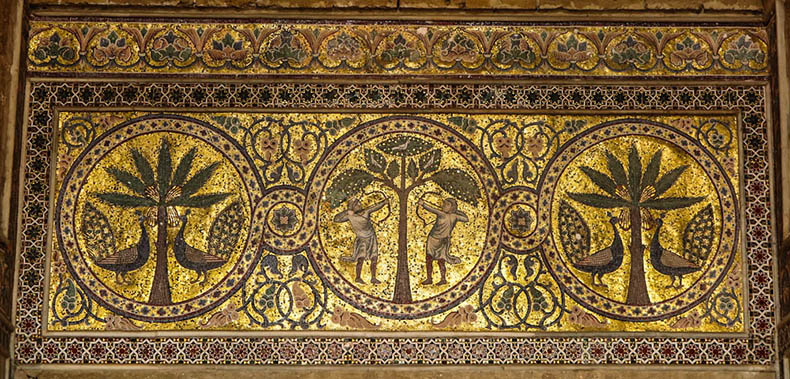
The Palace of Alexios Comnenos
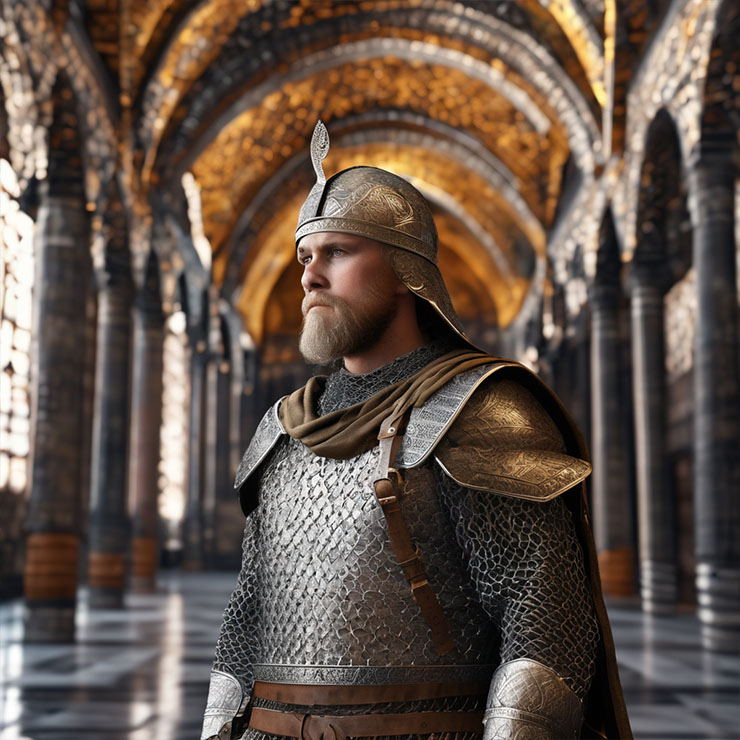 Before Alexios I, the iconoclastic emperor Theophilos renovated a palace that had been built by Marcian for his daughters called the Karianos and added enormous towers to the walls at the same time to protect it. The Karianos also had porticos, a church and an old-folks home attached to it. He also built the first chapel dedicated to Saint Thekla here. Nothing remains of the palace or the chapel, but the towers remain.
Before Alexios I, the iconoclastic emperor Theophilos renovated a palace that had been built by Marcian for his daughters called the Karianos and added enormous towers to the walls at the same time to protect it. The Karianos also had porticos, a church and an old-folks home attached to it. He also built the first chapel dedicated to Saint Thekla here. Nothing remains of the palace or the chapel, but the towers remain.
Alexios I Comnenus built a great hall in a new palace he built in the Blachernae. When he was in Constantinople Alexios lived primarily at Blachernae, although he moved to the Bukoleon and Mangana Palaces in his last days. It was at the Blachernae that he received the Crusader chiefs in 1096 and the Norse king Sigurd in 1107, and that he held the church Council of 1086 there. The palace was close to the wall and so tall that in 1096 a Norman soldier was able to shoot an arrow in though one of the windows of it and wound a courtier who was standing near the emperor. Alexios abandoned many of the formal ceremonies of the court; Alexios disliked useless ritual. The big reception halls of Great Palace existed primarily to host the old expensive ceremonies, involving thousands of useless courtiers, which he detested. Moving to Blachernae - a much smaller palace - enabled the emperor to cut down on the number of ceremonies and the number of participants. It was also much easier to protect from riots and the volatile mob that often dominated the politics of the city and had deposed emperors in recent times. The Great Palace housed the Imperial Mint and was full of valuable treasures and luxurious furnishings. It always was a magnet for potential looters. Finally it was close to Imperial hunting grounds just on the other side of the walls - so it was easy to slip into the countryside whenever he wished. Once a drunken crusader climbed into Alexios's lion enclosure between the walls of Blachernae to fight with them, there were six of them. A bunch of his buddies watched from the top of the wall and egged him on. The soldier managed to kill one - the most docile and oldest of the lions, who was Alexios's pet - and then the other lions pounced on him, killed the crusader and ate him.
It seems the rooms of Alexios's palace were by Byzantine standards and in comparison with the Bukoleon and Great Palaces rather austere in its decoration. Bohemond the Norman was only really impressed by the emperor's wealth when he was shown into a chamber that Alexios had especially filled with treasures to impress him. When the rooms of a palace were unoccupied their furniture was removed and used elsewhere. Also since Alexios's palace was new the interior decoration might not have been completed.
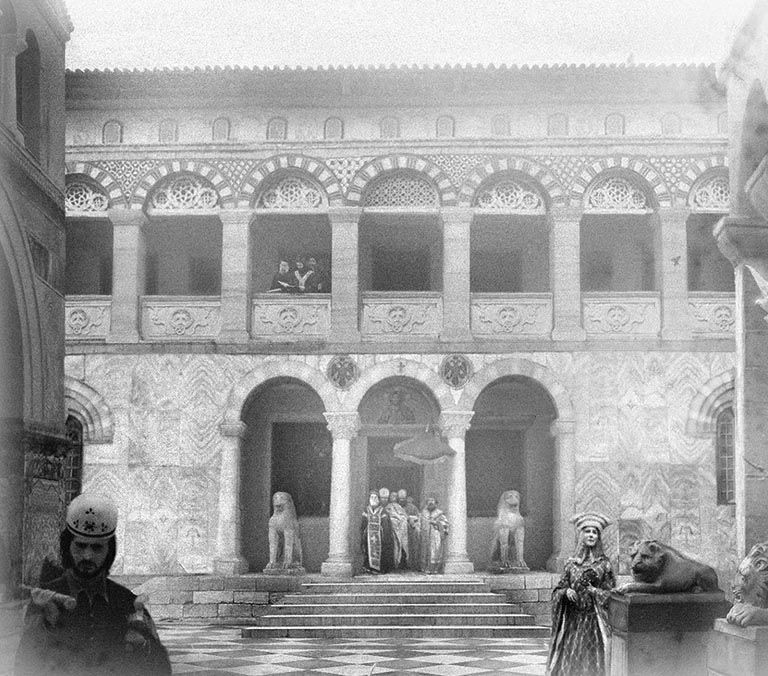 Above is a reconstruction of Alexios's palace by Antoine Helbert. Everything is accurate, including the costumes, the decoration and lions, which came from the Bukoleon Palace in the sea wall. He also built a bathhouse connected to his palace, whose substructures still survive in ruins. The Imperial church, dedicated to the Theotokos "Victory Giver", housed that icon, was attached to his palace and directly communicated with the main hall. Even though no remains of it can been seen today, the enormous foundations of the three Comnenian palaces of the Blachernae must still exist underground; one section of the massive Byzantine substructures were uncovered in this area in the 1950s. Once can look at the extensive remains of the Mangana Palace which still survive to get an idea of what could be found one day.
Above is a reconstruction of Alexios's palace by Antoine Helbert. Everything is accurate, including the costumes, the decoration and lions, which came from the Bukoleon Palace in the sea wall. He also built a bathhouse connected to his palace, whose substructures still survive in ruins. The Imperial church, dedicated to the Theotokos "Victory Giver", housed that icon, was attached to his palace and directly communicated with the main hall. Even though no remains of it can been seen today, the enormous foundations of the three Comnenian palaces of the Blachernae must still exist underground; one section of the massive Byzantine substructures were uncovered in this area in the 1950s. Once can look at the extensive remains of the Mangana Palace which still survive to get an idea of what could be found one day.
At the end of the 12th century the Emperor Alexios III set up a theatrical show for the wedding of his newly wed daughters and sons-in-law. As it was carnival time he put on mock horse races and pantomimes with music and gymnastics in the courtyard of one of the palaces before an audience of court officials and the imperial family. The Blachernae had plenty of space for big productions like this one.
One of the advantages of the Blachernae was it was much easier to get around from building to building than the Great Palace was. The old palace was swarming with court officials and workers from the Imperial agencies that were headquartered there and the passages and roads were clogged with people and carts. There were also thousands of Varangian Guard troops who were housed in barracks there. Plus there were a huge number of horses and other domestic animals stabled within the grounds of the Great Palace. When an Comnenian emperor was in the Great Palace he usually stayed in the Bukoleon which was offered some privacy by being walled off from the rest of the palace buildings and it was easy to enter and exit via its private dock. He could also receive guests privately here, something that would have been important to a man like Manuel who had affairs with multiple women at the same time. Another disadvantage of living in the Great Palace was it was noisy.
There was a public law court in the Blachernae (one could hear the deliberations in the courtyard outside it) and a branch of the imperial mint. There was also a water mill here that served the court. which ran on water from the aqueduct that brought water into Blachernae.
Aqueducts and the Water System of Blachernae
The historian Niketas Choniates:
"At great expense Andronikos rebuilt the ancient underground aqueduct which ran to the middle of the agora bringing up rainwater which was not stagnant and pestilential but sweeter than running water. He had the Hydrales River conducted through sluices into this water conduit, and near the streams that fed the river at its source, he erected a tower and buildings especially suited as a summer resort. Now all those whose dwellings happen to be in the vicinity of Blachernai and beyond are supplied with water from this source. He did not, however, restore the entire cistern so that the water could be channeled into the center of the agora, for the thread of his life had reached its end. Such was the concern of those who reigned after him, especially those who presently hold sway, to complete this work of common utility that Isaakios, who removed Andronikos from both throne and life, demolished the tower and razed these most delightful buildings in envy of Andronikos's magnificent work."
The water system of Constantinople was one of the great wonders of the city that can still be seen today. The engineering of the system showed the degree of skill the Byzantines had inherited from the Romans and continued to develop and expand. Anastasius and Justinian had been the first contributors to the aqueduct system which was necessitated by the growth of the population of the city in their reigns. Aqueducts crossed the Theodosian wall near the Blachernae and two enormous open air cisterns, those of Aetios and Aspar, had been carved out in the Deuteron heights. The water was brought from the Hydrales River. Later Manuel I had been pressured to invest in the water supply of the city which was failing to meet the needs of the population in his reign, which was approaching the same level as Justinian's era. Andronikos Comnenos came to the throne through a welter of bloodshed and over the dead bodies of the family and relatives of his late cousin Manuel. He killed both of his children along with Maria, his second wife from Antioch. Andronikos appealed to the people of the city by acting like he was their champion in attempting to improve their lives through things like public services. Andronikos began to expand the aqueduct, planning taking this water further into the city, where it was badly needed. His project stopped suddenly when he was - in a sudden turn of events - overthrown and killed by another mob like the one who had put him on the throne to begin with. As a part of this project he greatly increased the volume of water that the aqueduct carried into the city and built a big water tower in Blachernae and planned further channels from there into the city. His successor, the Emperor Isaac II Angelus demolished the tower because it was a reminder of the hated Andronikos that could be seen all over the city because of its location and great height. As a result the Blachernae and its neighboring districts benefited from a vast increase in their water supply but the rest of the city did not. The crusaders believed the city would fall quickly if the water supply into the city was cut. They thought it would be an easy task to disrupt it, but their efforts failed. The strength of the flow of water was so powerful they could not divert or block it. The 5 ft tall conduits of the aqueduct still survive. The aqueduct entered the city south of the Gate of the Kaligaria meaning "Gate of the Maker of Military Shoes", which was called the "Crooked Gate" in Ottoman times. After 1453 the Ottoman rulers restored and expanded the water supply from it. The water system and the fountain where it entered through the walls could still be seen and explored in 1907.
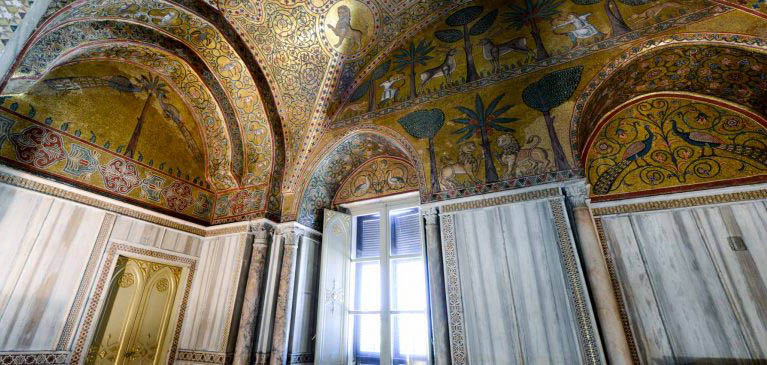 Above is another image of a Norman palace room in Sicily. The mosaics were created by court artists from Constantinople who duplicated work they had done in Blachernae.
Above is another image of a Norman palace room in Sicily. The mosaics were created by court artists from Constantinople who duplicated work they had done in Blachernae.
The Lofty Palaces of Manuel I Comnenus
Alexios I's grandson, Manuel I Comnenos, built at least two other palaces, one for his German wife, Bertha-Eirene and another huge one for himself which was higher up on the hill that was described as being "exceedingly high". Bertha of Sulzbach was the sister-in-law of the German Emperor Conrad III and was plain, dull and stupid. Manuel could not abide her and built a separate palace for her in order to avoid her. Manuel lived almost entirely in his own new palace apart from her. You entered it though a colonnaded portico that was decorated with mosaic scenes of his heroic exploits, which was updated with new scenes as he achieved new triumphs. This palace had beautiful marble columned loggias and balconies carved with lions and other creatures. The floors were set with beautiful opus sectile work in elaborate patterns of rare colored marbles that was highly polished and looked like carpets. He set up a throne of gold precious stones and s golden crown suspended by a golden chain over it. The exterior walls were set with glazed decorative brickwork in intricate patterns. It had a tall peaked roof covered in lead plates. Since the 10th century, Byzantine palaces were tall. The Mangana Palace, built alongside the Monastery of Saint George near the sea wall on the Bosphorus was five stories tall. Alexios's palace was built on lower ground than Manuel's but made up for it by its great height which caught the gentle fresh breezes of the neighborhood and provided splendid views over the walls and other nearby buildings. These palaces were connected by colonnaded courtyards and were set in gardens and fields of grassy meadows planted with fruit trees, roses and flowers. The gardens were inhabited by doves, peacocks, parrots and swans. There were channels of water and fountains - it was a mini-paradise with its protective walls. A river of fresh water from the aqueduct went right down the center of Manuel's great hall and there were flowering trees on either side. The water course was carved in marble, with special patterns carved in it that made the movement of the water sound like music. The palaces were built at right angles to each other creating a central core and two long wings. There was also a chapel to the Theotokos here on the square and a great mural icon of Saint George on horseback. The wall around Blachernae had towers and gates. The most important one was a triple-arched gate which was decorated with a life-sized relief of the Goddess Victory, which has survived until today. You can see it below on this page.
Manuel's palace had lots of space around it. He was fond of western-style tournaments and jousting which he had plenty of room to conduct nearby. Hunting was another one of his passions and another reason for his preference for Blachernae.
Manuel also built new walls to protect the district. His primary goal was to move the wall further out, to place his new palace beyond the range of catapults. His single wall, which was built on a steep slope, was stronger and taller than previous parts of the land walls. Because of the hill it did not have a moat. The ramparts were wider - 15 ft. - and the towers were more closely spaced. The first 6 towers are alternately octagonal and round, the next 2 are octagonal and the last one is square. There was one gate and two posterns. Between the 2nd and third towers facing north is the small postern gate, which the Byzantine historian Phrantzes, and the last emperor, Constantine XI Dragases used to reconnoitre the Turkish camp on the eve of May 29th, when the city fell. The Ottomans attempted to breach the wall of Manuel I Comnenus in 1453 without success, neither with cannon or by tunneling underneath them.
Odo of Deuil described Blachernae which he saw in 1147 on a visit to Constantinople in 1147 during the Second Crusade with King Louis VII of France and Eleanor of Aquitaine:
"There is set what is called the Palace of Blachernae which, although it is rather low, yet, rises to eminence because of its elegance and its skillful construction. On its three sides the palace offers to its inhabitants the triple pleasure of gazing alternately on the sea, the countryside, and the town. The exterior of the palace is of almost incomparable loveliness and its interior surpasses anything that I can say about it. It is decorated throughout with gold and various colors and the floor is paved with cleverly arranged marble. Indeed, I do not know whether the subtlety of the art or the preciousness of the materials gives it the greater beauty or value."
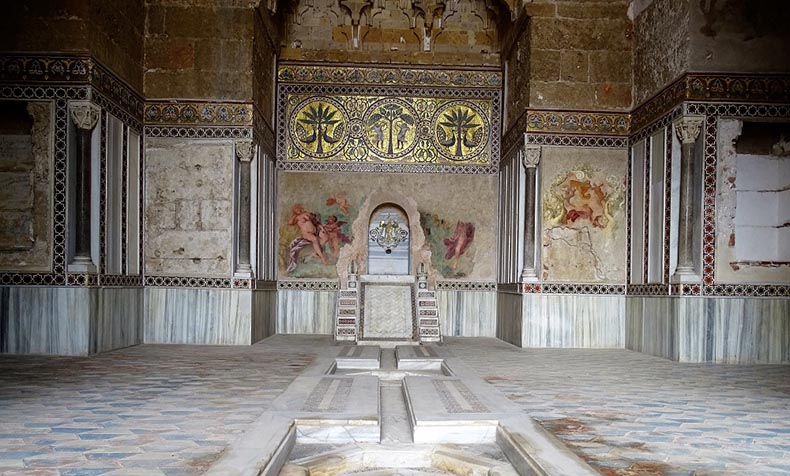 Above is an image of the Norman Ziza palace in Sicily which was built at the same time and was directly modeled on Manuel's palace. The mosaics were done by artists from Constantinople who had worked for him. The water channel down the center of the room is a duplicate of Manuel's water feature in his throne room. It has a waterfall and has large inset fountains.
Above is an image of the Norman Ziza palace in Sicily which was built at the same time and was directly modeled on Manuel's palace. The mosaics were done by artists from Constantinople who had worked for him. The water channel down the center of the room is a duplicate of Manuel's water feature in his throne room. It has a waterfall and has large inset fountains.
Hunting and Lion Keeping
The Comnenian emperors built their palaces here - away from the Great Palace for the healthier climate and to be near the walls and their hunting grounds of the Philopation Palace which were on the other side of the walls here. Alexios I kept his five lions is a special enclosure here. The emperors collected other animals like panthers who were trained to ride horses. In Byzantium men and women both hunted. The palace of the Philopation was used to house foreign guests, like the Crusader kings, who were best kept outside the walls with their armies. The hilly hunting grounds of this palace were not forested, they had gullies filled with brush and brambles, which were used primarily for boar, deer and rabbit hunting. Hawks were also used to hunt. Hunting was a dangerous sport in Byzantium and several emperors were killed in hunting accidents. Poisoned spears were often used in boar hunting and this is what killed John II, Manuel's father, who was accidentally stabbed with one. In 1437 the Spanish historian and traveler Pero Tafur wrote about the hunt he went on at Philopation with the emperor and his wife, Maria, who rode astride:
"This day the Emperor sent for me to go hunting, and we killed many hares, and partridges, and francolins, and pheasants, which are very plentiful there, and when we returned to the Palace I took my leave and went to my lodging, where he had ordered that I should be provided with whatever I had need of. Without doubt, it was the Emperor's wish to show me much honor and favor, and from that day onwards, when he or the Empress, his consort, desired to hunt, he sent horses for me, and I went with them, and they said that they had great pleasure in my company... The Empress rides astride, with two stirrups, and when she desires to mount, two lords hold up a rich cloth, raising their hands aloft and turning their backs upon her, so that when she throws her leg across the saddle no part of her person can be seen. The Greeks are great hunters with falcons, goshawks, and dogs. The country is well stocked with game both for hawking and hunting, and there are quantities of pheasants, francolins, partridges, and hares. The land is flat and good for riding."
Splendors and Decoration of the Palaces
Alexios and Manuel's palaces had ground floors built with columns and vaulted arches that were used as service rooms and for access to the upper floors. The palaces were dominated by huge multi-storied halls that were used as throne rooms, for meetings, celebrations and for banquets. They could hold several thousand people whose walls were covered by rich marble revetment. The ceilings were sometimes made of carved wood which was painted in rich colors and gilded. If a ceiling was made of vaulted brick it was covered with gold mosaic. These great halls had apses that were set with more mosaic showing members of the Comnenian dynasty accompanied by Christ, the Theotokos and saints. In buildings erected by Manuel I he was always the number one actor in these displays until he had a son and added him to them. The colonnaded porticoes of the palaces were also decorated with golden mosaics depicting Manuel's many victories and triumphs. It was very splendid and sumptuous - there was nothing like it anywhere in the West. The layout of the palaces made them seem like they were much bigger than they were. Visitors reported there were several hundred rooms.
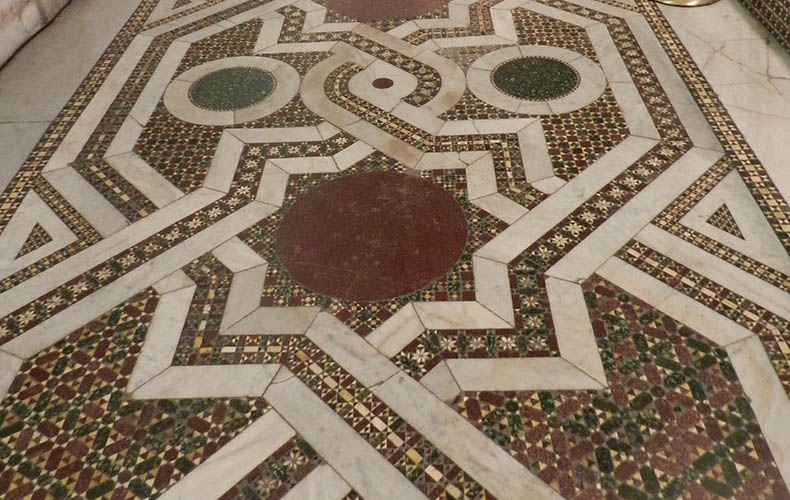 Above is an example of what the floors in Blachernae would have looked like.
Above is an example of what the floors in Blachernae would have looked like.
These new palaces were not only places of splendor, they were also Imperial residences. Manuel saw himself as the true universal Roman emperor and lived according to his position. There were many personal apartments for emperors, their extended family and guests. Some of them functioned as independent establishments and had their own kitchens, service staff and stables. Manuel went so far as to create special quarters for his Muslim guests, designed for the practice of their own religion. Not surprisingly some of the most pleasant rooms were at the tops of the palaces - which could be five or more stories. They had windows set with glass panes and huge wooden shutters. Sometimes the winds were strong enough that the glass windows had to be temporarily removed to protect them. If there were long periods of time when parts of the palaces were unoccupied they were closed up. Furniture was moved around from one palace to another and his personal suite of furnishings could follow him as he traveled. Byzantines either slept on beds or on benches that were built-in around the walls of rooms and covered with mattresses. In domestic settings whole families would sleep in the same big room. Emperors always slept with a servant in their bedroom and guards outside the door. Valuable things - like silver chandeliers, candlestands and basins even followed an emperor when he was on campaign. The walls of palace rooms were covered in marble, painted or decorated with mosaics. The rooms had stone floors - always with elaborate designs in colored marble and mosaic. Carpets were used everywhere, including in churches. Windows, beside being glassed were hung with curtains of silk and linen. Often they were transparent and embroidered with gold thread.
How Byzantine Emperors Lived - Luxury and Ceremony
Beyond windows, Byzantine emperors used lots of glass. It came in the form of drinking vessels, dishes, hanging lamps, containers and bottles. It came in colored glass blown with designs and glass that was painted in enamels and gilded with both gold and silver. Emperors had their own personal libraries that were manged by secretaries who also handled their correspondence. An individual emperor could have dozens of secretaries. Clothes were managed by their own court officials - the closer you got to an emperor the more prestigious the position. Like most Byzantines, emperors preferred to use bathhouses in the Roman fashion, and they shared them with their relatives and friends. These bathhouses could be small and intimate or have large bathing pools. The palaces of the Blachernae where served by underground aqueducts and underground cisterns. The aqueducts provided a special sweet water that was clean and fresh.
Palace kitchens were always built apart from the palaces they served - the danger of fire was always present. Imperial banquets were served with gold and silver plates,which were kept in stacks. The food was served to the emperor first who sat alone at his own table on a raised platform. He was personally served by a high court official, then his guests were served from heaping platters of food. You were served on gold or silver depending on your rank. Sometimes you were allowed to keep the gold or silver dish you were served on. Diners used spoons, knives and forks - the Byzantines were reputed to have invented the fork - which was viewed as a devilish luxury in the west. Wine was served in glass vessels. People at banquet used big linen napkins. Banquet tables were made of slabs of marble, even in taverns and restaurants. There were short-order kitchens in palaces that were used for quick meals and to reheat stuff. They also provided hot and cold water. Some emperors preferred these and did their own cooking.
The traveller Ibn Battuta visited Constantinople in 1351 during the reign of Andronikos III and described an imperial banquet in a Blachernae palace. The "khatun" is a relative of the emperor who he has escorted back to Constantinople who had married a Muslim ruler and was now returning. He begins by telling us about his first visit to Blachernae to meet the emperor, he is most likely visiting the Manuel I Palace which was recently renovated by Andronikos's father:
“On the fourth day after our arrival in Constantinople, the khatun sent the slave Sunbul the Indian to me, and he took my hand and led me into the palace. We passed through four gateways, each of which had archways in which were foot soldiers with their weapons, their officer being on a carpeted platform. When we reached the fifth gateway the slave Sunbul left me, and going inside returned with four Greek youths, who searched me to see that I had no knife on my person. The officer said to me: "This is a custom of theirs; every person who enters the king's presence, be he noble or private citizen, foreigner or native, must be searched." The same practice is observed also in India. After they had searched me the man in charge of the gate rose and took me by the hand and opened the gate. Four of the men surrounded me, two of them holding my sleeves and two behind me, and brought me into a large hall, the walls of which were of mosaic work, in which there were pictures of creatures, both animate and inanimate. In the center there was a stream of water, with trees on either side of it, and men were standing to right and left, silent, not one of them speaking."
“In the midst of the hall three men were standing to whom those four men delivered me. These took hold of my garments as the others had done, and on a signal from another man led me forward. One of them was a Jew, and he said to me in Arabic "Do not be afraid; this is their custom that they use with one who enters. I am the interpreter, and I come from Syria." So I asked him how I should salute the Emperor, and he told me to say "As-salam alaykum."
“After this I reached a great pavilion, where the Emperor was seated on his throne, with his wife, the mother of the khatun, before him. At the foot of the throne were the khatun and her brothers, to the right of it six men and to the left of it four, and behind it four, every one of them armed. The Emperor signed to me, before I had saluted and reached him, to sit down for a moment, in order that my apprehension might be calmed. After doing so I approached him and saluted him, and he signed to me to sit down, but I did not do so. He questioned me about Jerusalem, the Sacred Rock, the Church of the Holy Sepulchre, the cradle of Jesus, and Bethlehem, and about the city of Abraham [Hebron], then about Damascus, Cairo, Iraq, and Anatolia, and I answered all his questions about these, the Jew interpreting between us. He was pleased with my replies and said to his sons "Treat this man with honor and ensure his safety." Then he bestowed upon me a robe of honor and assigned me a horse with saddle and bridle, and an umbrella of the kind which the king has carried above his head, that being a sign of protection. I requested him to designate someone to ride in the city with me every day, that I might see its marvellous and rare sights and tell of them in my own country, and he appointed a man as I had asked. They have a custom that anyone who wears the king's robe of honor and rides his horse is paraded round with trumpets, fifes and drums, so that the people may see him. They do this mostly with the Turks who come from the territories of Sultan Uzbeg, so that the people may not molest them, and I was paraded in this fashion through the bazaars."
"After this long trip about the city, we paraded back to the palace for the nightly meal. To my astonishment, the King had a feast prepared in my honor, and we began. An endless assortment of different types of meat, pastry, and drink were present. The King, knowing that I did not drink alcohol, presented me with a drink of fermented beets and apples, which I found extremely flavorsome. The chef was very artistic in his presentations of the foods, with such delicacies as pastries containing roasted birds or fruits preserved in honey and sugar."
When Ibn Battuta left Constantinople the emperor made a gift of the the two horses he had used to ride around the city.
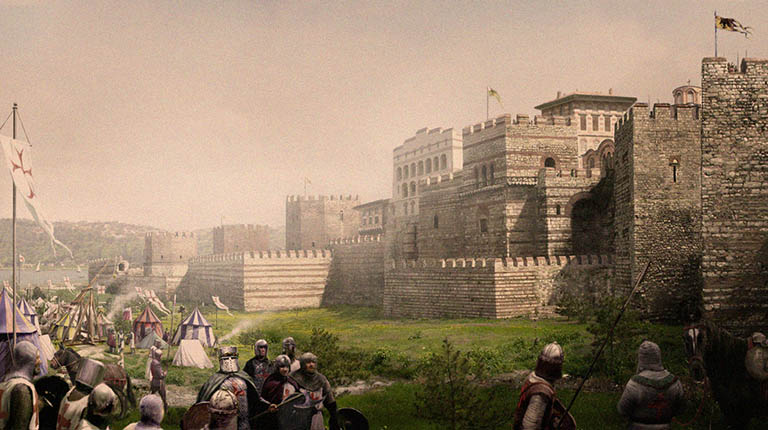 Above, crusaders of the Fourth Crusade camped outside the walls of Blachernae. This is another illustration by Antoine Herbert.
Above, crusaders of the Fourth Crusade camped outside the walls of Blachernae. This is another illustration by Antoine Herbert.
Keeping the Palaces in Tip-Top Shape
Palaces had to have regular cleanings. The Blachernae was particularly blessed with ample supplies of flowing water for its cleaning. Their schedule followed an emperor and his family as they moved from one palace to another. As soon as they left everything was washed and scrubbed from top to bottom. Rosewater was used for its fragrance. Throughout the year floors were strewn with rosemary, myrtle and grape leaves. The walls and corridors were also hung with giant garlands of flowers and fragrant herbs. Incense and fragrant woods were simmered in heated braziers or burned in swinging and hand-held censors. Small glass bottles of rosewater were used to anoint guests hands and faces. Emperors had their own personal perfumeries stocked with all of the most useful and rare fragrances which were mixed in special heated silver basins. They traveled with him, even on military campaigns, with its own special luggage.
There was a great deal of polishing, even the marble was refreshed with warm encaustic waxes. The mosaics were regularly checked for loose tesserae and reset or replaced where necessary. Gilding was renewed where it was worn. There were thousands of silver lamps, candle stands, chandeliers, serving dishes and plates that had to be cleaned and polished all the time. The palace had its own team of lamplighters who were responsible to light the rooms with candles and oil lamps. Many of the chandeliers were hung in lofty locations and had to lowered to be lit or accessed by ladders and walkways along cornices.
Dressing the Emperor
An emperor's wardrobe was immense. There were formal clothes used on special occasions there were difficult to put on and wear. Some were very heavy with jewels and gold embroideries. Emperors avoided certain ceremonies for this reason. A few revolted and refused to wear the proscribed articles of clothing. Others simplified Imperial dress, not only to avoid its weigh, but to save money. The Imperial loros is a good example. It was heavy and impossible to move in. The Paleologian emperors made the loros smaller and cut down on the gold and jewels which was cheaper and lighter to wear. He would be expected to change many times in the same day. Different colors and patterns were required for special occasions; a special mourning color was required based on the position of person who was deceased or his relation to you. Emperors always wore hats or crowns. Imperial underwear, sheets, stockings and towels were made of fine linen that was embroidered in gold thread. It was even given as gifts to other royals. The Imperial workshops and tailors who made these things had regular annual orders for all these things which were paid for once year. They involved thousands of things that were made at different levels of quality. The highest quality always went to the emperor and lower quality items were given as gifts. There were two qualities of gold thread, solid gold wire and gilded silver. All imperial clothes had special containers and luggage made for them that was stamped with royal symbols and monograms. An active emperor like Manuel I usually dressed in highly tailored silk kaftans that closely fit his body. This style of clothing - designed for riding or hunting - originated in Central Asia and came to Byzantium in the 7th century. It was modified a little over the years as fashions changed. The level of quality was dictated by the grade of the silk and the lining, which was usually linen. The emperor wore special shoes in red and purple that only he could be seen in. The most ornate were sewn with gold, pearls and gemstones in the pattern of eagles. There was a special color red-purple that was reserved for the emperor. Sometimes his closest relatives and highest court officials were allowed to ear a few strands of it. At one time this color was extracted from Murex mussels, but later it was made from other dyes.
Changing Times - the Blachernae Palaces Under the Paleologian Emperors
In Paleologian times the life and ceremonies of the Imperial court retreated to the palaces and churches of Blachernae and took on an entirely different character and scale. The palaces of Alexios and Manuel had survived the Fourth Crusade and the Latin occupation, but they required extensive cleaning and restoration. It is said this took 10 years! The Latins had even stripped the buildings of their lead roofs for money. The great halls were covered by black soot from the open fires they set in them to keep warm and cook food. Windows were broken and not replaced, rooms were abandoned rather than cleaning them. The gardens were overgrown and the water system had broken down.
There were two receptions in the palace everyday that were attended by office holders and presided over by the emperor, which involved hundreds of participants. This is why so many office holders had to live close to the palace, since they walked to it. The emperor sat during them, while the others stood, although standing in the presence of the emperor was not required. If you had to approach him there were three levels of bowing. The first involved bowing from the waist, the second was done on ones knees while the third was done prostrate on the ground. In this period the wearing of uniforms for most officials was discontinued, court officials could wear any silk outfit they wanted. In earlier times the Emperor had made gifts of clothes to officials. This was discontinued because of the expense and silk garments were now widely available at reasonable prices. Everyone wore hats based on ones rank and occupation.
Many church councils were held in Alexios's palace in the 14th and 15th centuries, which tells us it was functioning and in use right up until 1453. Alexios's palace was lower down and closer to populated areas than Manuel's. Many of the attendees of the synods - which could go on for a considerable period of time - were older churchmen, would have walked to them and would have wanted to lodge nearby. There were still a number of monasteries in the immediate area that could house them. Alexios's palace was still splendidly decorated and fully functional - which undermines the view that the imperial court was now housed in diminished circumstances. There is one account of a traveler who visited the emperor in the 5th century who says he was badly lodged in just a few rooms. It is now understood that he visited the emperor in what remained of the Great Palace after visiting Hagia Sophia. In those days a small part of the Great Palace was maintained - amidst the ruins - as an Imperial apartment for visits to Hagia Sophia. The emperor had a small throne room there, too. Up until almost the end, (the last emperor was not crowned in Hagia Sophia) Imperial coronations were celebrated in Hagia Sophia and were accompanied by days of feasting and celebration. Money was still thrown to senate and people of the city as a part of the ritual. But Imperial court life was now centered around two those two great courtyards of the Blachernae. The coronation celebrations started in the old Augusteon outside Hagia Sophia and then moved there. The great processions that used to take the emperor weekly throughout the city ended and moved to organized parades to a few nearby chapels and churches in the northwest corner of the city. Hagia Sophia was only visited six times year because the emperor was too poor to provide the former donations to the clergy his visits required. Long gone were the days when the emperor entered the sanctuary and placed 100lbs of gold on the altar as a gift!
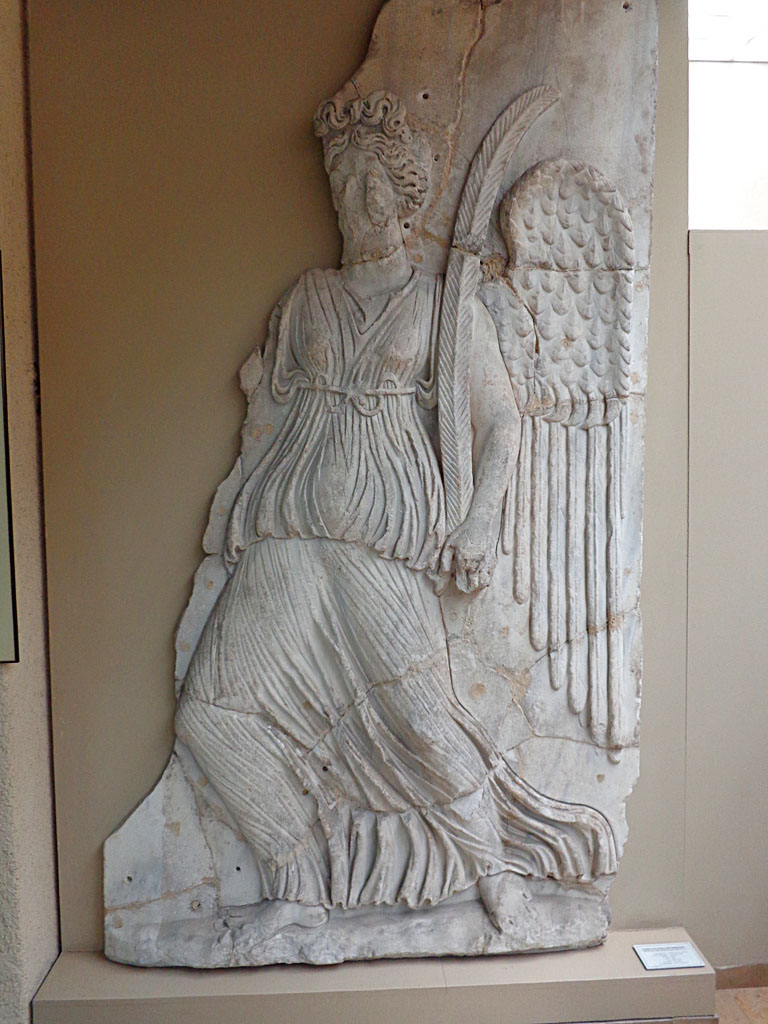 Above is a marble Victory that was mounted in the gates of the Blachernae. There were three arched entrances to the private Imperial harbor, this part of the Sea Wall as was demolished in 1868. It looks like it's from the reign of Theodosius I. It came to the museum in 1894. From historical records we know it was paired with a marble relief of the Theotokos.
Above is a marble Victory that was mounted in the gates of the Blachernae. There were three arched entrances to the private Imperial harbor, this part of the Sea Wall as was demolished in 1868. It looks like it's from the reign of Theodosius I. It came to the museum in 1894. From historical records we know it was paired with a marble relief of the Theotokos.
The Varangian Guard in Blachernae
The former Varangian Guard still served the emperor, but they only accompanied him on horseback from the palace to its gates, where they would greet him on his return to the palace. The horses were still splendid and the uniforms, arms and many banners were smart and colorful. In the city the emperor was accompanied by family members and court officials. There were many banners carried in procession. People could approach the emperor when he rode in procession outside the place and present petitions to him. Music was played to announce the emperor was coming so people would know he was coming their way. When the procession arrived at its destination banners would be erected on poles. Every member of the Imperial family had his own symbol or shield - even dragons - that was placed on his banner. Every court official had one as well. There was still a senate and people to acclaim him in many of the old ceremonies on a reduced scale. From time to time the palace courtyard and streets of the city still echoed with trumpets, drums, wind instruments and water organs. When the emperor wanted to ride seven splendid horses were offered to him and he would select the one he wanted to ride. The other horses followed him when he set out from the palace, just in case he needed to change one.
The Palace of the House of the Porphyrogenitus - Tekfur Saray
After the Latin emperors were ejected from Constantinople there was a short period of unreserved optimism about the future. Michael VIII began redecorating the colonnades of Manuel's palace with new paintings of his own military exploits, but they were not finished at his death. He also added a library to it. Some new palaces were built before the disasters of Andronikos II ruined the finances of the state and ended Byzantine rule in Asia Minor forever. The most famous of these - because it still survives - was the House of the Porphyrogenitus - which means "Born in the Purple Chamber". It was built for Constantine, third son of Michael VIII and dates between 1261 and 1291. The top story of the palace was another vast wood-roofed reception room. The famous facade was decorated with heraldic symbols of the Paleologian dynasty, was recently ruined in a dreadful restoration as an Ottoman tile museum that has finally opened in 2019.
Constantine and Eirene's oblong palace was built between two walls which descend from the Porta Xylokerkou for a short distance, towards the Golden Horn. Its long sides, facing respectively north and South, are transverse to the walls, while its short western and eastern sides rest, at the level of the second story, upon the summit of the walls. The whole surface of the building was decorated with beautiful patterns in brick and stone mosaic. The many windows of the palace are framed in marble and their were graceful balconies on the east and south, which looked out over the superb views the lofty position of the palace commanded. The palace was connected by elevated corridors to the palaces in the lower part of the Blachernae.
Today, besides Tekfur Saray, an underground prison, the pathetic remains of the baths of Alexios I, and one Imperial balcony, nothing remains of Blachernae above ground except for it's walls and terraces. The site has been thoroughly ransacked for building materials to build new structures. Every exposed spot has been dug up in search of treasures. Nothing is documented when it is found. Anything of value is sold on the black market or melted down as scrap metal. Anything that shows a cross or any other Christian symbol is effaced by religious zealots. The Turkish state is still ruled by Islamic fundamentalists who celebrate the successes of the Islamic State of Iraq and the Levant in destroying anything that is not Sunni or Christian. Today the best place to get an idea of what the Blachernae was like is to visit Mystras in Greece. Here they have reconstructed the 15th century Palace of Manuel II, which sits on a courtyard with wings of earlier palaces - really castles - attached to it. It is now called the Place of the Despots and it stands among churches and small colonnades that were built to stand-in for Blachernae in the last days of the empire.
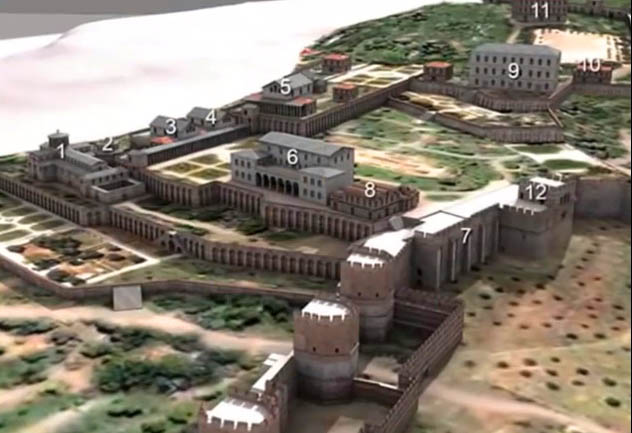 Above is a reconstruction of the Blachernae from Byzantium 1200, looking up the hill to the north. 1) Church of the Theotokos; 2) Holy Soros; 3) Anastasiakos Hall; 4) Danubius Hall; 6) Palace of Alexios I; 7) Prison of Anemas; 8) Baths of Alexios I; 9) Palace of Bertha-Irene; 11) Palace of Manuel I; 12) Balcony & Tower Chambers of Isaac II Angelus.
Above is a reconstruction of the Blachernae from Byzantium 1200, looking up the hill to the north. 1) Church of the Theotokos; 2) Holy Soros; 3) Anastasiakos Hall; 4) Danubius Hall; 6) Palace of Alexios I; 7) Prison of Anemas; 8) Baths of Alexios I; 9) Palace of Bertha-Irene; 11) Palace of Manuel I; 12) Balcony & Tower Chambers of Isaac II Angelus.
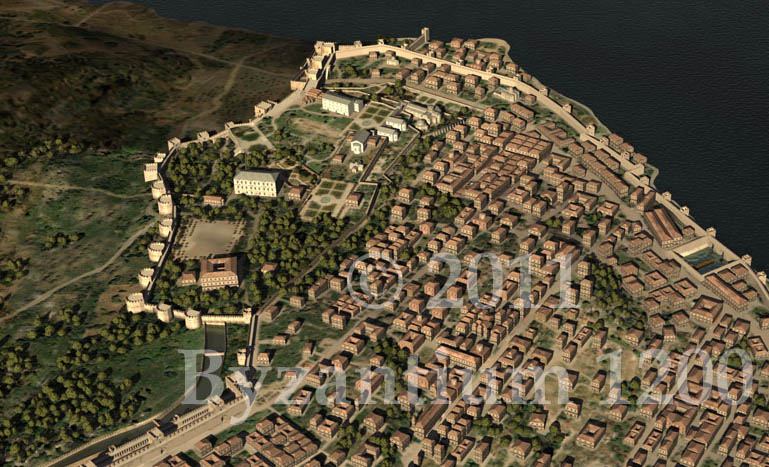 Above is another reconstruction of the Blachernae from Byzantium 1200 looking south towards the Golden Horn. At the very top is the private Imperial harbor. The white building near the top is the Palace of Alexios I; to the east of it is the church of the Theotokos; below them to the left is the gray Palace of Bertha-Irene and further down, near the great courtyard, is the palace complex of Manuel I colored brown. The Palace of Manuel I was actually the biggest of the three. At the top on the left, shaded out, is the location of the Palace of the Philopation and its hunting grounds. Alexios I kept his lions just outside the walls here.
Above is another reconstruction of the Blachernae from Byzantium 1200 looking south towards the Golden Horn. At the very top is the private Imperial harbor. The white building near the top is the Palace of Alexios I; to the east of it is the church of the Theotokos; below them to the left is the gray Palace of Bertha-Irene and further down, near the great courtyard, is the palace complex of Manuel I colored brown. The Palace of Manuel I was actually the biggest of the three. At the top on the left, shaded out, is the location of the Palace of the Philopation and its hunting grounds. Alexios I kept his lions just outside the walls here.
Disaster at the Hands of the Fourth Crusade
During the initial assault of Fourth Crusade in July 1203 the Blachernae was bombarded by catapults and the palaces were damaged. Emperor Alexios IV brought the crusaders into Blachernae to negotiate with them. In desperation he offered to turn over the palaces to his western friends if they guaranteed him protection during any attack on the city. His duplicity was discovered by his subjects, he was overthrown and strangled to death. The new Emperor Alexios V Mourtzouphlos moved into Blachernae. In August, the crusaders set fire to nearby homes along the Golden Horn and the fire spread from here, burning most of the city.
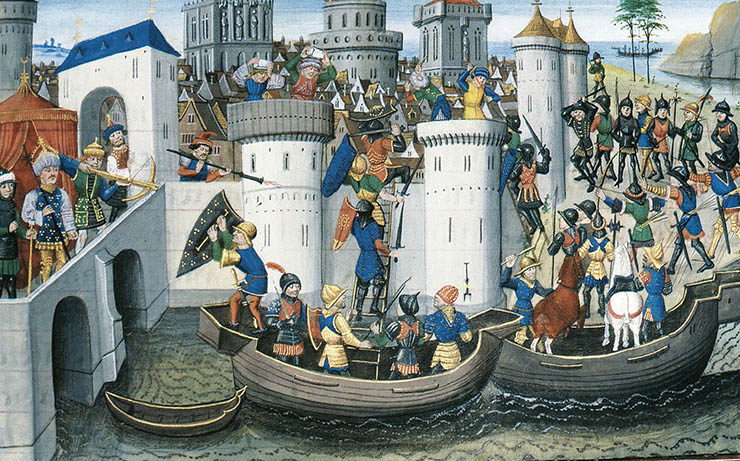 On April 13, 1204 the crusaders broke through the fortifications here using a battering ram. The Imperial guard who was left in the palace surrendered to Henry, the brother of Count Baldwin of Flanders, on the promise that none of the people in the palace would be harmed. The promise, once made, was not honored. He immediately set his own guard over the palace to ensure the treasures in the palace would all be his. Most of the servants would have brought their families into the palace for protection during the assault. All of people within the palace who could not ransom themselves were forcibly ejected from it and were immediately set upon by other crusaders waiting for them in the courtyard. Servants and courtiers were stripped and searched for any valuables they had on them.
On April 13, 1204 the crusaders broke through the fortifications here using a battering ram. The Imperial guard who was left in the palace surrendered to Henry, the brother of Count Baldwin of Flanders, on the promise that none of the people in the palace would be harmed. The promise, once made, was not honored. He immediately set his own guard over the palace to ensure the treasures in the palace would all be his. Most of the servants would have brought their families into the palace for protection during the assault. All of people within the palace who could not ransom themselves were forcibly ejected from it and were immediately set upon by other crusaders waiting for them in the courtyard. Servants and courtiers were stripped and searched for any valuables they had on them.
Being so close to their point of entry, the Theotokos Church was the first to be looted and striped of its treasures. It was full of people from the neighborhood who mistakenly hoped they would be safe here. It was incomprehensible that to them that their own fellow Christians could want to harm and rob them. They didn't know that the crusader bishops had authorized their extermination because they said they said the Byzantines were not truly Christians but heretics. Looting was also authorized for the same reason. Children were not to be spared. The Bishops joined into the killing and looting themselves. Just in case, some Latin clergy hired other crusaders to do the dirty work for them, so they could avoid potential sin.
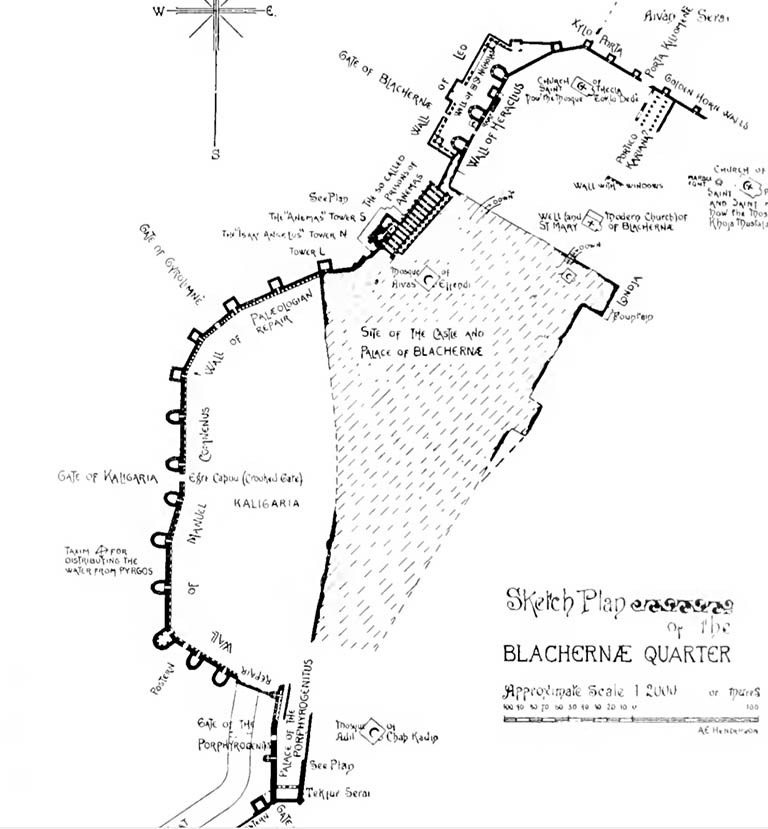 Above is a map of the Blachernae.
Above is a map of the Blachernae.
Once they were in the church the crusaders pulled the silver covers from the icons turning them into gaming boards, destroyed the gilt-silver ciborium and altar and carried off the sacred vessels used in the liturgy and used them as drinking cups. Many of the crusaders had visited the church before the attack and knew where everything was. Common people and clergy were tortured in order to make them confess where things had been hidden. Mobs of soldiers and camp followers swarmed over the churches and palaces looting and pillaging. Every woman who could be grabbed was raped, including young girls and nuns. The Latins collected immense piles of silks, pulling curtains from windows and rummaging through chests of Imperial clothing looking for valuables. Desiring the palaces as their own residences the leaders of the crusade intervened to stop the destruction of the palaces and set guards over them. Even though they initially lusted over them, the crusaders living in the palaces like barbarians. After one palace had been ruined by them they simply moved to another one and repeated the same destruction there. They rounded up former Imperial servants and tried to force them into service, but they couldn't pay them and had to let them go. They forced out the Greek Orthodox clergy and installed French clergy, who were incapable of running the churches and chapels. The job was simply too big for the few clerics who the Pope sent to Constantinople. The Venetian and the French clerics fought over who would control which churches and monasteries. The Venetians got the prize of Hagia Sophia. The churches crumbled around them and the Latin Emperors were to poor to support their maintenance or pay their salaries. The Catholic clergy sold off stuff from their churches to raise money. Unfortunately during their occupation the Latins failed to repair all the damage they had done to the district in the assault. Many historic and beautiful buildings that might have been restored were lost through this misuse and willful neglect.
In the last years things became so bad for the Latin Emperor Baldwin II that he was forced to sell the lead joints stripped from his own palaces. Perhaps he had been persuaded that the joints could be removed without damaging the last palaces he had to live in. Sculpture, marble and columns was also gathered up and sold. It was stored in towers near the harbor for easy transport. Buyers could select from a huge inventory of beautiful things, leaving behind broken pieces that have recently been found in the Mangana. The Venetians were able to carpet the facade of San Marco with Byzantine things from stores like this.
On June 21, 1302 14 Venetian ships commanded by Belletto Giustinian sailed into the Golden Horn accompanied by 7 pirate ships which they had picked up ion the way in Crete and Negroponte. They anchored opposite the Blachernae palace and their men went ashore to do as much damage as they could. They set fire to bales of straw that they found on the shore in front of the walls. The resulting flames could be seen from the city and the nearby palaces where the emperor was resident. Too late Andronikos II, never a forceful or decisive leader, realized that without ships he was absolutely powerless to retaliate. A bridge of boats was suggested to be built across the Golden Horn from Imperial troops could attack the Venetians. Andronikos thought that this would do more harm than good. When night fell the pirate ships attacked the nearby Princes Islands in the Sea of Marmora. They were crowded with refugees from the Turks in Asia Minor. Such of them as could not afford a ransom were murdered. Others were brought within sight of the Blachernae and tortured before the emperor's eyes with the connivance of the Venetians. The emperor protested to their commander Giustinian, sending him 4000 hyperpyra as ransom money for the surviving refugees.
During the civil wars in 1347 there was more fighting around the palaces of the Blachernae. This was just a year after the dome and eastern arch had collapsed in Hagia Sophia! The Empress Anne of Savoy was surrounded in the Palace of Bertha-Eirene by John Cantacuzene and 1000 men (mostly mercenaries and even Turks) who broke into the city and stormed their way into the fortified area around the Blachernae palaces. During the fighting the tower-gate to the main courtyard was destroyed. Anne was forced to negotiate with the rebels to save the throne for her son John Paleologos, who was 15 years old at the time. Anne had to agree to allow John Cantucuzene to reign as co-emperor with him. She ended up a prisoner in her own palace and had to pawn the crown jewels and remove silver and jewels from icons in order to save herself and her son from ruin.
In August 1348 the Latin Genoese, who controlled Galata, brazenly sailed along the coast of the Golden Horn, burning ships along the way to force the Byzantines to grant them more trade rights. They attacked the Church of the Theotokos and the monastery of Christ the Savior with catapults, but the people of city saw the stones slide harmlessly off of their lead roofs. They saw it as a miraculous act of the Virgin of the Blachernae, who had intervened once more to save the city. The area around the church was still densely populated and the church was very popular with the merchants and artisans that lived in the area.
John VIII began negotiations to end the schism of the churches. His goal was to raise help for the empire from the pope and the western kings of European Christendom to repel the Turks, who it was expected would soon arrive outside the walls of the city. After long negotiations over the proposed terms of reunion by Byzantine envoys, John himself with a huge entourage of church and state officials and scholars, boarded papal ships to Italy to attend the Council of Ferrara in 1437. He had to borrow the money to cover the costs of the mission. The Byzantines made a powerful impression on the Italians for their splendid retinue, sophisticated manners and classical education. The Council was a success in concluding a union of the churches, but the promised military campaign was a failure and the people of Constantinople rejected the union their rulers had agreed to without their consent.
With such troubles it is understandable that repairs to historic churches and palaces had to be put on hold. The survival of Constantinople was hanging the balance. What money there was had to be spent on repairing the walls and cleaning out the moat.
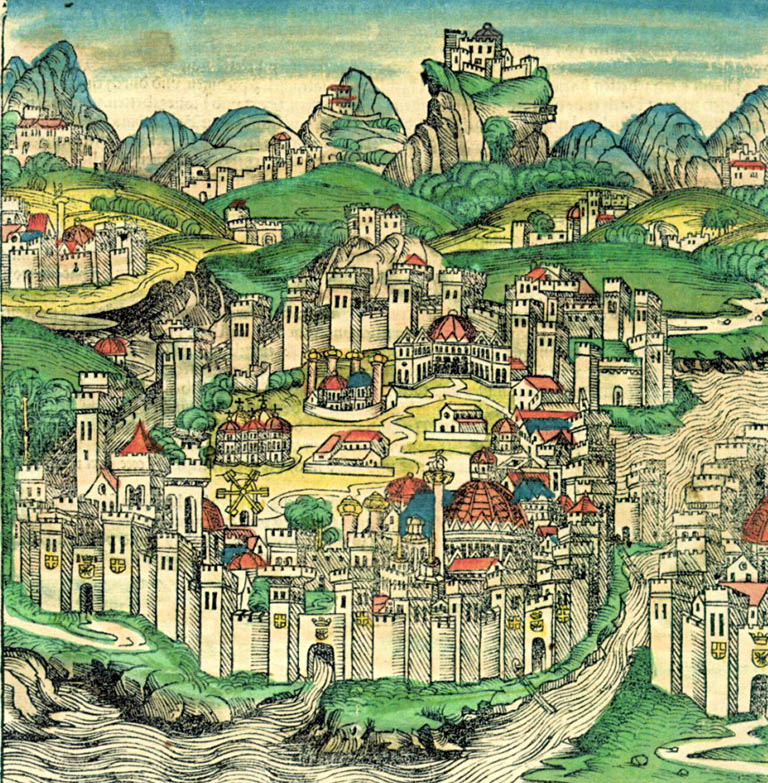
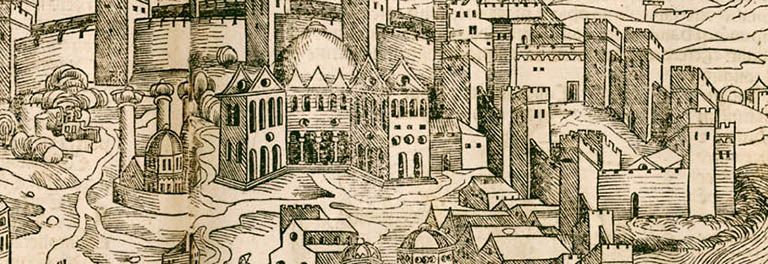
Above are two 15th century map of Constantinople printed by Schedel. At the center top you can see the Blachernae palaces grouped around a large courtyard. The center palace has a high pitched wooden roof.
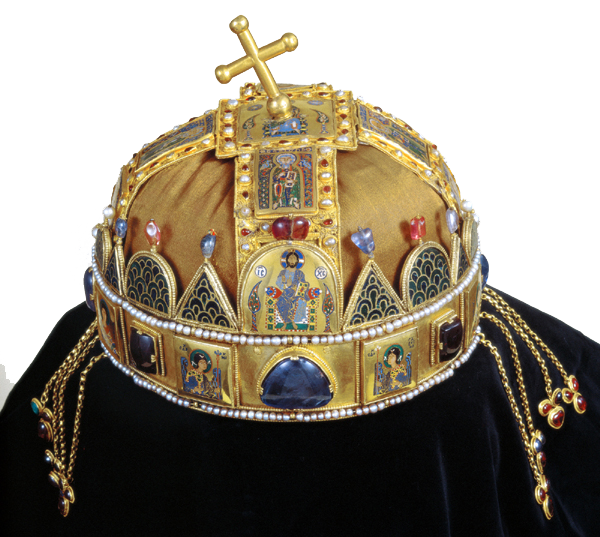
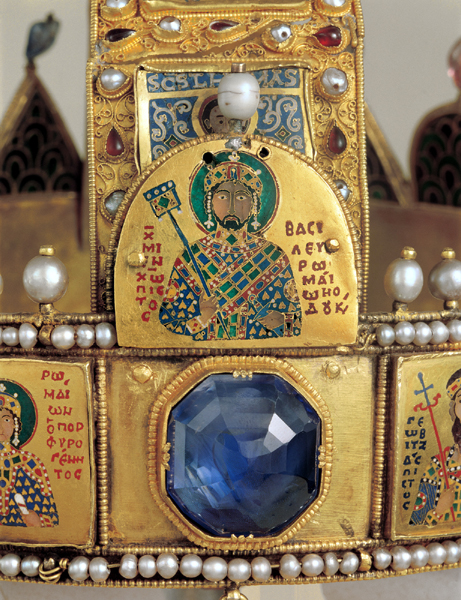
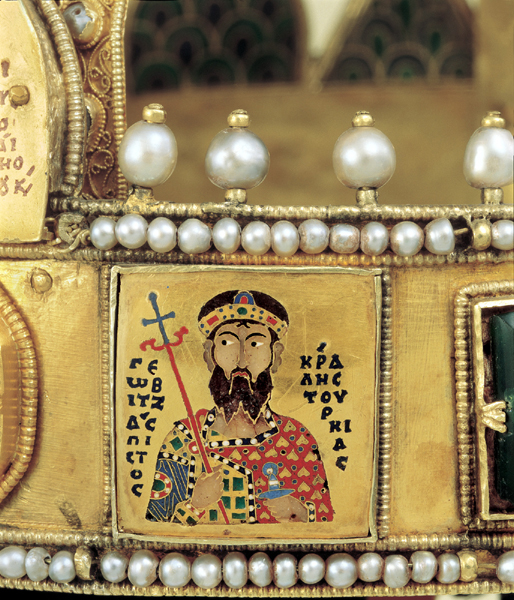
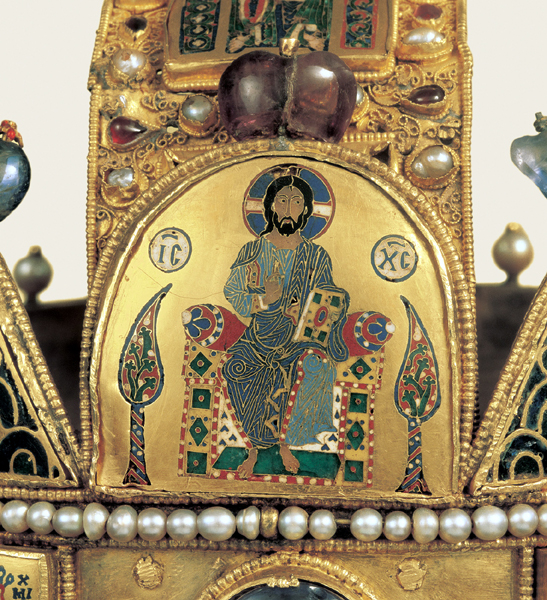
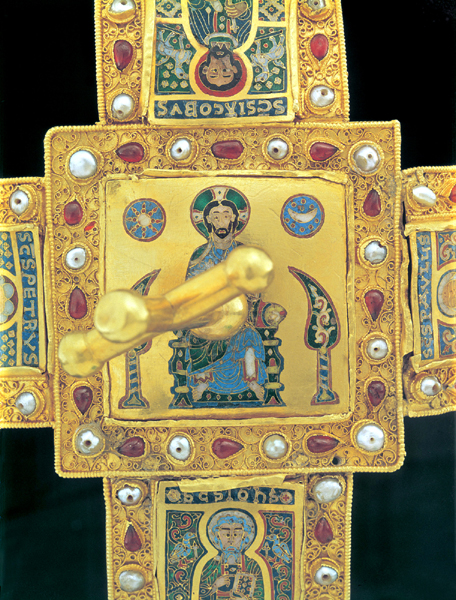
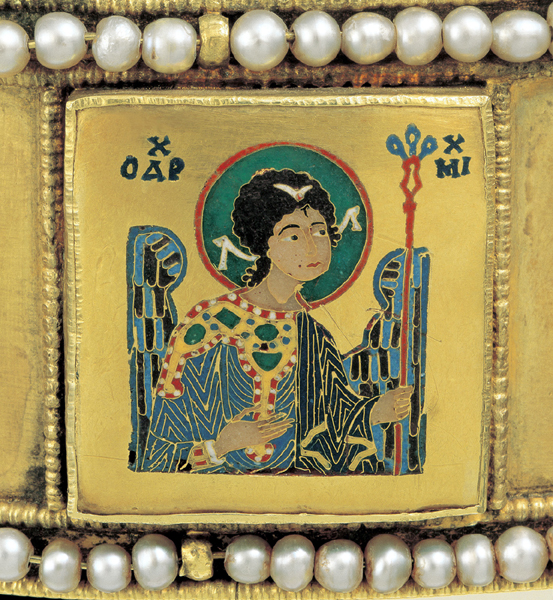
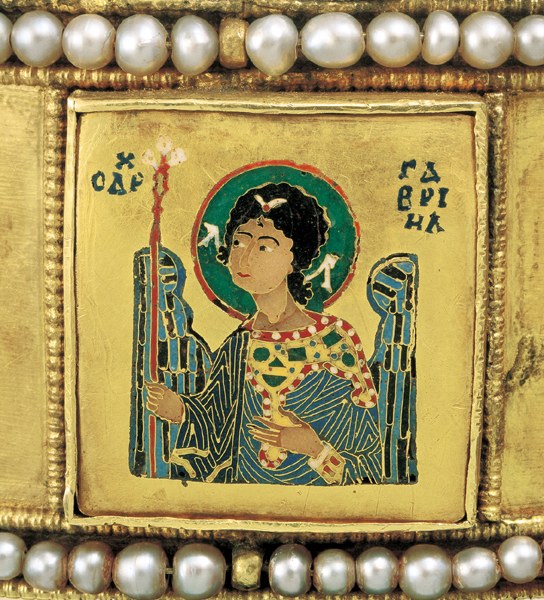
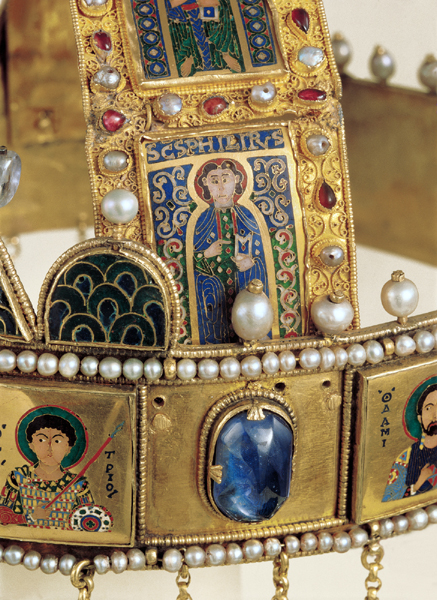
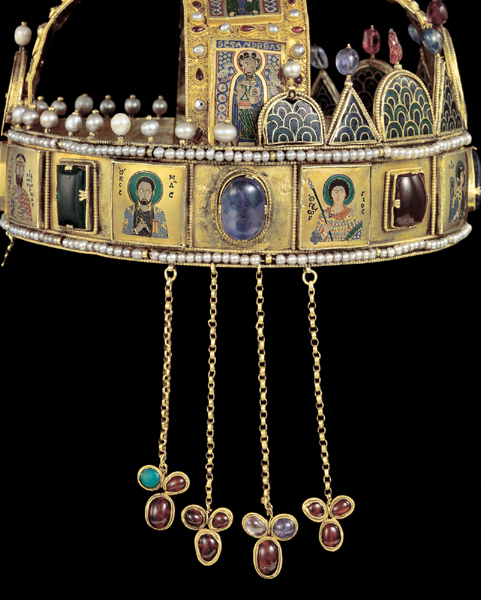
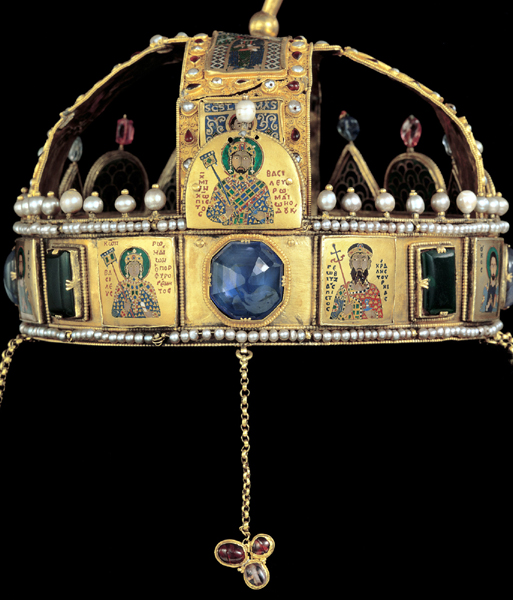
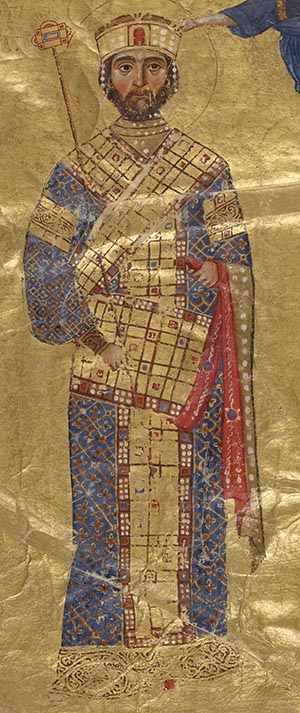
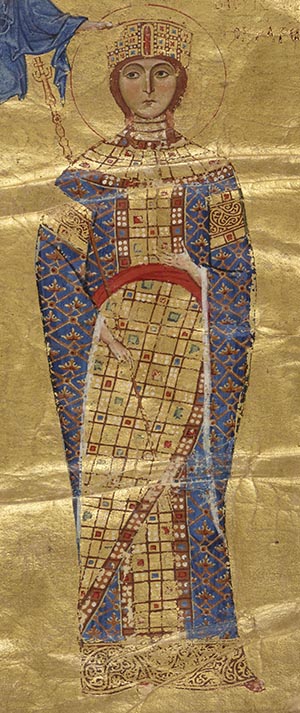


 The Blachernae palaces were described as being upper or lower based on their position on the hill. The upper gate, Ta Hypsela, was closest to the Church of Mary Theotokos - south of it - and was the location of service buildings and the stables. Court officials did not live in the place, but came everyday for the regular ceremonies. There was a special quarter for them in the Blachernae called "ta Pittakia". Before the erection of the Comnenian palaces there were two buildings the hosted the Emperor when he came to Blachernae for church festivals and feasts. One was a big building called the Anastasiakos and the other was called the Danubius. These buildings may have been abandoned or fallen into ruin because they aren't mentioned after Alexios built his big "Alexiakos triklinos" which in Greek means Alexios hall but should be understood to describe a palace. These palaces were dominated by huge reception halls - at least two stories tall - that ran across the building lengthwise.
The Blachernae palaces were described as being upper or lower based on their position on the hill. The upper gate, Ta Hypsela, was closest to the Church of Mary Theotokos - south of it - and was the location of service buildings and the stables. Court officials did not live in the place, but came everyday for the regular ceremonies. There was a special quarter for them in the Blachernae called "ta Pittakia". Before the erection of the Comnenian palaces there were two buildings the hosted the Emperor when he came to Blachernae for church festivals and feasts. One was a big building called the Anastasiakos and the other was called the Danubius. These buildings may have been abandoned or fallen into ruin because they aren't mentioned after Alexios built his big "Alexiakos triklinos" which in Greek means Alexios hall but should be understood to describe a palace. These palaces were dominated by huge reception halls - at least two stories tall - that ran across the building lengthwise.
 Before Alexios I, the iconoclastic emperor Theophilos renovated a palace that had been built by Marcian for his daughters called the Karianos and added enormous towers to the walls at the same time to protect it. The Karianos also had porticos, a church and an old-folks home attached to it. He also built the first chapel dedicated to Saint Thekla here. Nothing remains of the palace or the chapel, but the towers remain.
Before Alexios I, the iconoclastic emperor Theophilos renovated a palace that had been built by Marcian for his daughters called the Karianos and added enormous towers to the walls at the same time to protect it. The Karianos also had porticos, a church and an old-folks home attached to it. He also built the first chapel dedicated to Saint Thekla here. Nothing remains of the palace or the chapel, but the towers remain. Above is a reconstruction of Alexios's palace by Antoine Helbert. Everything is accurate, including the costumes, the decoration and lions, which came from the
Above is a reconstruction of Alexios's palace by Antoine Helbert. Everything is accurate, including the costumes, the decoration and lions, which came from the 






 On April 13, 1204 the crusaders broke through the fortifications here using a battering ram. The Imperial guard who was left in the palace surrendered to Henry, the brother of Count Baldwin of Flanders, on the promise that none of the people in the palace would be harmed. The promise, once made, was not honored. He immediately set his own guard over the palace to ensure the treasures in the palace would all be his. Most of the servants would have brought their families into the palace for protection during the assault. All of people within the palace who could not ransom themselves were forcibly ejected from it and were immediately set upon by other crusaders waiting for them in the courtyard. Servants and courtiers were stripped and searched for any valuables they had on them.
On April 13, 1204 the crusaders broke through the fortifications here using a battering ram. The Imperial guard who was left in the palace surrendered to Henry, the brother of Count Baldwin of Flanders, on the promise that none of the people in the palace would be harmed. The promise, once made, was not honored. He immediately set his own guard over the palace to ensure the treasures in the palace would all be his. Most of the servants would have brought their families into the palace for protection during the assault. All of people within the palace who could not ransom themselves were forcibly ejected from it and were immediately set upon by other crusaders waiting for them in the courtyard. Servants and courtiers were stripped and searched for any valuables they had on them.






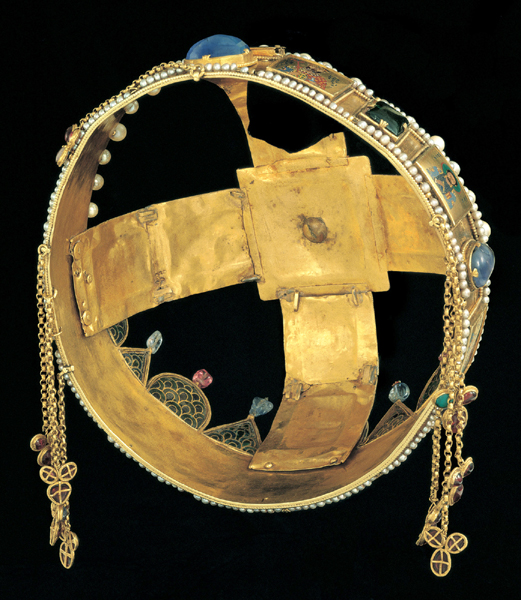
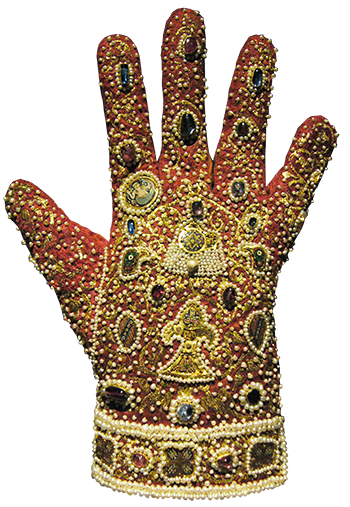
 click here for icons of christ
click here for icons of christ click here for icons of the theotokos
click here for icons of the theotokos click here for icons of angels
click here for icons of angels click here for icons of saints
click here for icons of saints








